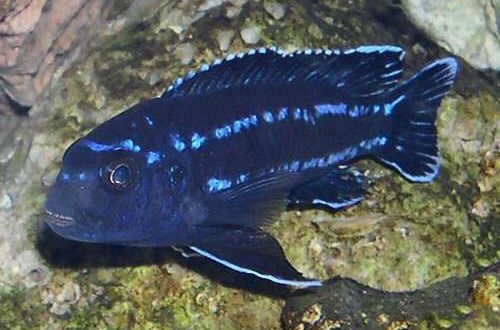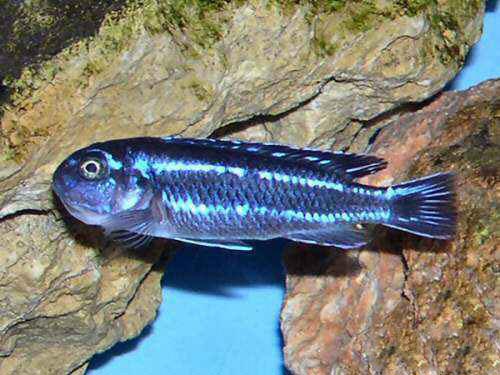
Maingano
Melanochromis meingano, scientific name Pseudotropheus cyaneorhabdos, belongs to the Cichlidae family. A relatively new species, it received a scientific description only in 1997, although it was discovered a long time ago, but for a long time it was mistaken for a variety of another very similar species of Melanochromis Johan.

The representative of African cichlids from Lake Malawi belongs to the Mbuna group, which unites 13 genera and is distinguished by the aggressiveness and territorial behavior of its representatives. Translated from the local dialect, “Mbuna” means “dwellers of the rocks”, which reflects their habitat.
Requirements and conditions:
- The volume of the aquarium – from 120 liters.
- Temperature – 23-28°C
- pH value – 7.0-8.0
- Water hardness – medium hardness (10–18 dH)
- Substrate type – sand with rocks
- Lighting – moderate
- Brackish water – allowed at a concentration of 1,0002
- Water movement – strong / moderate
- >Size – 7-10 cm.
- Nutrition – a combination of plant and meat products
- Life expectancy – up to 9 years.
Habitat
Endemic to Lake Malawi in Africa, it lives mainly along the rocky coastline of Likoma Island, one of the largest in the lake. Prefers to stay at moderate depths from 3 to 10 meters, feeds on algae covering rocks, along the way eating small crustaceans, snails, insect larvae and other zooplankton hiding in the plant litter.
Description

A small cichlid, has an elongated body with a rounded nose. In the oral cavity there are incisors designed to cut hard algae from stones. A low fin stretches almost along the entire back. The main color is dark blue with two blue horizontal stripes. The fins and tail are trimmed with a thin blue stripe.
The shape and color of the body is similar to the close relative Melanochromis Yohana, which often led and still leads to confusion.
Food
Omnivorous species, accepts all types of dry and frozen food with herbal supplements. The diet should be varied, feeding only one type of food is not acceptable. The optimal composition is as follows: frozen or live foods (insect larvae, bloodworms, small crustaceans) combined with vegetable flakes, such as spirulina or other cichlid supplements.
Specialized feeds for various groups of cichlids are widely available on sale (in retail or via the Internet), which contain all the necessary vitamins and microelements.
Feed two or three times a day in an amount that will be eaten within 5 minutes, the remains should be removed to avoid water pollution.
Maintenance and care
A group of 3-4 fish will require a tank of 120 liters or more. In the design, it is necessary to recreate the shallow water of the rocky coast. From fragments of rocks and large stones rising to the surface, numerous grottoes and gorges are formed, which serve as shelter. Fine sand soil, it is recommended to use coral sand, it helps to maintain the required alkaline pH level. Usually there are no plants, but as a decorative effect, you can arrange a small amount of vegetation in groups.
Mingano requires a certain composition of water – slightly alkaline (pH) medium hardness (dH), sea salt concentration of about 3 grams is acceptable. per liter of water. More details on how to change the pH and dH parameters in the “Hydrochemical composition of water” section.
Cleanliness is just as important. Water should be renewed once a week by 30-40% with simultaneous cleaning of the soil with a siphon from organic waste (food residues, excrement). A large role is given to the filtration system, it is recommended to purchase the most productive equipment based on financial capabilities. A high-quality filter will reduce the cost of maintaining the aquarium, in this case, water renewal can be done much less frequently.
The minimum required set of equipment, in addition to the filter, consists of a lighting system, aeration and a heater. Due to the lack of plants, the aerator becomes the main source of dissolved oxygen in the water, make sure that the number of spray stones is sufficient and they provide small bubbles. The smaller the bubble, the faster the gas exchange.
Behavior
Violent aggressive fish. Males are aggressive towards each other, as well as towards outwardly similar species, with little experience in keeping cichlids, it is advisable to get by with a species aquarium with one male and several females. Mingano prefers a harem way of keeping.
Breeding / Reproduction
In favorable conditions and a balanced diet, spawning is quite possible in a home species aquarium. In this case, the aquarist will not require additional effort or expense. When the male is ready for the mating season, his coloring becomes more intense, and he begins to invite females to his territory.
The female lays from 10 to 60 eggs, after which she immediately takes them into her mouth – this is an evolutionarily developed protective mechanism. For fertilization, a less exotic method is provided. On the anal fin of the male there is a pattern of several bright dots resembling eggs in size and color. The female during spawning mistakenly takes them for her eggs and tries to swallow, at this moment the male releases the seed and fertilization occurs.
Further, the entire incubation period passes in the mouth, depending on the temperature, it lasts about 21 days. The female protects the offspring that has appeared for several more days; in case of danger, the juvenile hides back into the female’s mouth.
Feed the fry with micro food. They grow quickly, in a few weeks they reach 3-4 cm, at this age it is worth starting to think about their further relocation, otherwise the male may begin to consider them as potential competitors.
Fish diseases
A typical disease of all cichlids from Lake Malawi is the Malawi bloat disease of the same name, which is primarily associated with unsuitable housing conditions and an incorrect monotonous diet. Read more about symptoms and treatments in the Aquarium Fish Diseases section.
Features
- A quarrelsome species in relation to other fish
- Requires high water quality
- Need a balanced, varied diet





